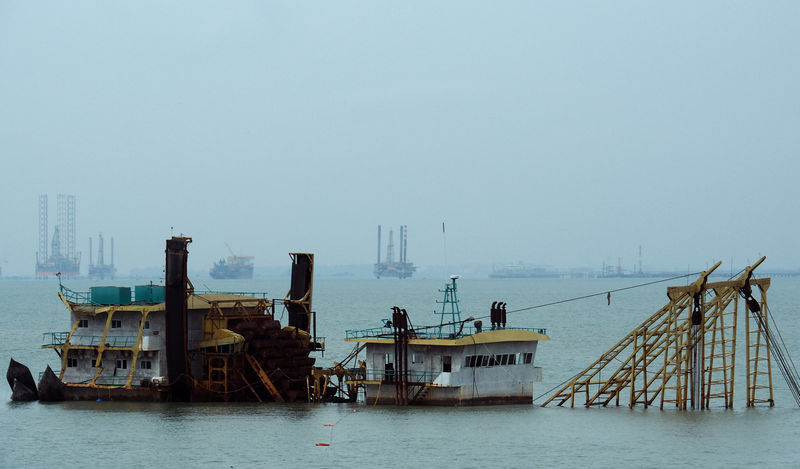By Henning Gloystein and Gavin Maguire
SINGAPORE (Reuters) - Surveying the ocean floor for oil and natural gas reserves is gradually emerging from a multi-year slump, everywhere apart from Asia.
That's despite Asia being the world's biggest consumer of oil, having by far the strongest demand growth while seeing its production fall faster than anywhere else.
The reasons for Asia's dearth in offshore exploration and production (E&P) include high costs in Australia's promising waters, declining reserves in production hotspots Malaysia and Indonesia, as well as territorial disputes in the oil- and gas-rich waters of the South China Sea.
"We only have two 3D vessels in Asia-Pacific, since there are fewer opportunities and less activity in that region," said Bard Stenberg, vice president at Norwegian offshore survey company PGS (OL:PGS), adding that most of his company's vessels were in the Atlantic.
GRAPHIC: World regions by oil production vs consumption, click http://reut.rs/2AV1T8z
MISSING OUT
A 2017 and 2018 activity map by geophysical surveillance firm TGS (OL:TGS) shows the most activity in the North Atlantic.
A similar map by Bernstein Research showed the Asia-Pacific basin to have only four minor offshore developments of under 50,000 barrels per day (bpd). That compares to five major developments (above 50,000 bpd) and 11 minor ones in the Atlantic.
Asia's dearth comes despite the region's huge oil deficit, resulting from booming demand and declining output.
In one of the most promising regions, Australia, the main problem is cost, in part due to a requirement for rigs to pay for Australian crew once in Australian waters.
"Once any foreign-flagged vessel is in Australian waters, the ship operator has to pick up Australian workers... They work 12 hours a day, 7 days a week for 4 weeks, then get 4 weeks off," said Christy Cain of the Maritime Union of Australia.
When oil prices were high, this was not a big problem, drillers said. But in times of cheaper oil and low profit margins, the added cost deters explorers, several said.
In another promising area, the South China Sea, conflicting territorial claims, especially between China and Vietnam, have hindered E&P activity.
Meanwhile, in Asia's most established offshore oil and gas production basins of Malaysia and Indonesia, recoverable reserves are depleting.
Malaysia's state-owned Petronas, Southeast Asia's biggest oil producer, is increasingly focussing on downstream projects like the Pengerang Integrated Complex (PIC) in the southern state of Johor.
From 2019, PIC will refine crude oil into fuel and petrochemical products. Significant amounts of its crude will come from Saudi Arabia.
With little E&P activity, Asia's oil import bill - which has already more than doubled since 2000 to over $420 billion a year - will rise further, likely above $500 billion in 2017, leaving other regions to cash in on Asia's oil thirst.
GRAPHIC: Regional oil production vs demand balance, click http://reut.rs/2AZUll2
COUNTING HELICOPTERS
Gauging the health of the secretive offshore industry is difficult. But dozens of mothballed rigs and support vessels sit idle in southern Malaysia's Johor river delta, waiting to be used or scrapped.
Yet cautious optimism is emerging.
"Activity to support new development projects may increase slightly (between 2018 and 2020), but is unlikely to approach historical high levels (2013/14)," Petronas said in an outlook this month.
Douglas Westwood, which monitors helicopter activity to and from offshore vessels, has a similar view.
"The offshore helicopter market has finally started to recover following three years of decline," Westwood said, although it added that average annual growth between 2018 and 2022 will still only be 1 percent.
"Global utilisation will average 59 percent over the forecast," it said, up from a paltry 54 percent in 2017.
At the root of the industry malaise lies rampant overproduction in the years running up to 2014, which crashed crude prices (LCOc1) from over $100 per barrel in 2014 to below $30 in 2016.
E&P companies were among the first to feel the bite of aggressive industry cost slashing.
Firms in the seismic oil surveillance sector, including Polarcus (OL:PLCS), PGS, and Electromagnetic Geoservices (OL:EMGS) have seen their share prices crash since 2015, in some cases by over 90 percent.
Only a production cut led by the Organization of the Petroleum Exporting Countries (OPEC) has stabilized Brent above $50 a barrel since mid-2017.
With oil demand healthy, the offshore industry hopes companies will start spending on future output again.
"We're hoping that it's going to pick up next year," said Cain of the Maritime Union of Australia.
In a sign that even in Asia-Pacific there may be some more activity, the geothermal surveillance ship Polarcus Naila left Singapore in early December for a seismic mission in the Bonaparte Basin, off Australia's northwest coast.
Speaking to Reuters during a visit to Singapore by the ship, one of the Naila's senior crew members said he hoped things would go from "worst to bad."

GRAPHIC: Stock market performance of selected marine geophysical companies, click http://reut.rs/2BI1bil